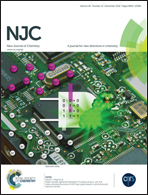Thermogravimetric investigation on the interaction of formic acid with solder joint materials†
Abstract
Soldering is a dominating process for semiconductor packaging. For electronic manufacturing tin based solders play a key role. The surface of most solder alloys is oxidized under an oxygen containing atmosphere. Usually reducing chemicals, called fluxing agents, are used to enable the formation of solder contacts. However, standard liquid flux leaves aggressive residues on the electronic devices. Clean processes were developed using gaseous flux, i.e. formic acid vapor. Despite the competitiveness of the reducing effect of formic acid vapour on many solder alloys, only little is known about the corresponding reaction mechanism, especially at the surface. An oxidized copper powder and a tin–silver–copper alloy were investigated using thermogravimetric and mass spectra analysis under formic acid flow. Details on the adsorbed and desorbed species and the formation of intermediates and decomposition products are presented. Activation temperatures are estimated and correlated with heating processes.


 Please wait while we load your content...
Please wait while we load your content...